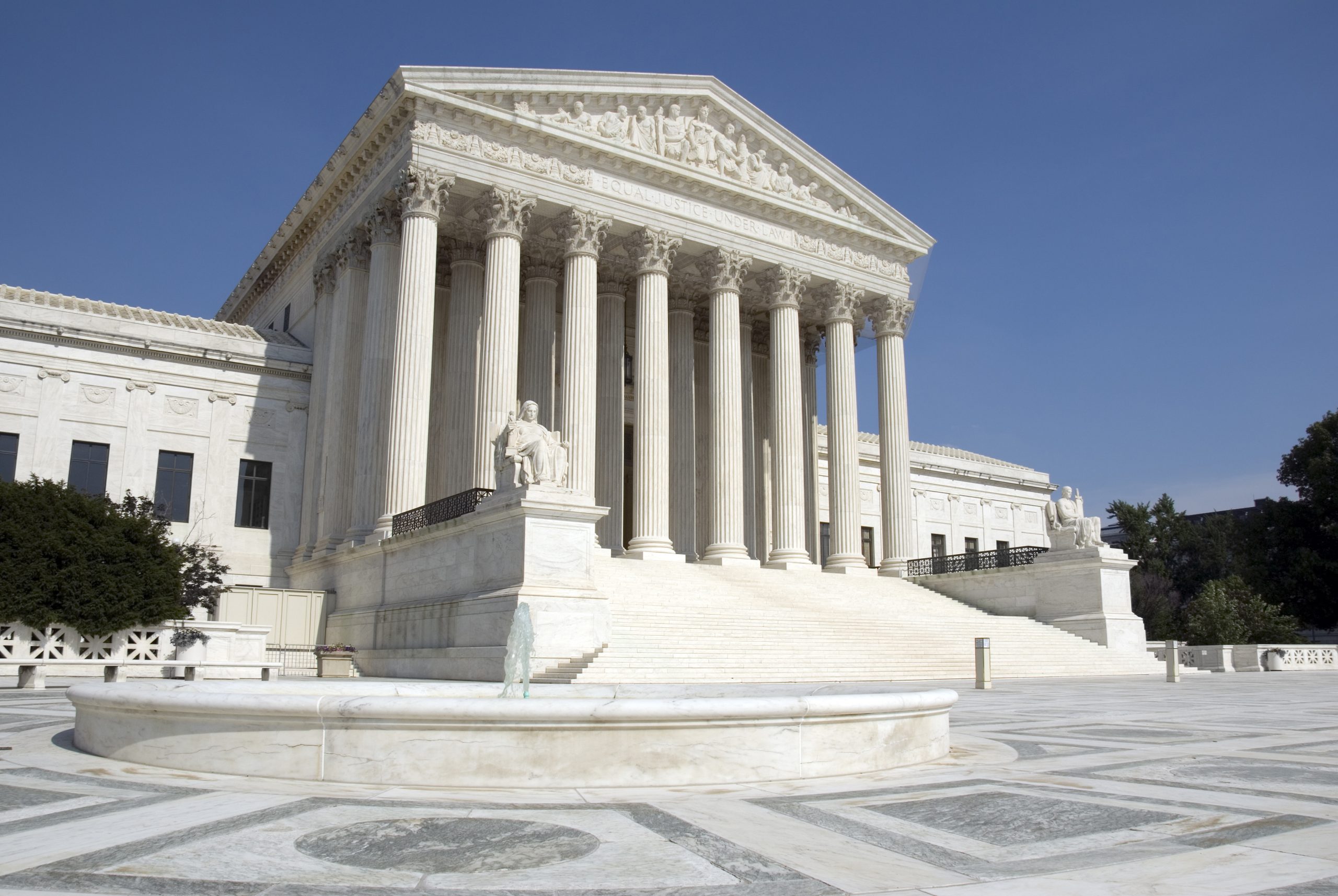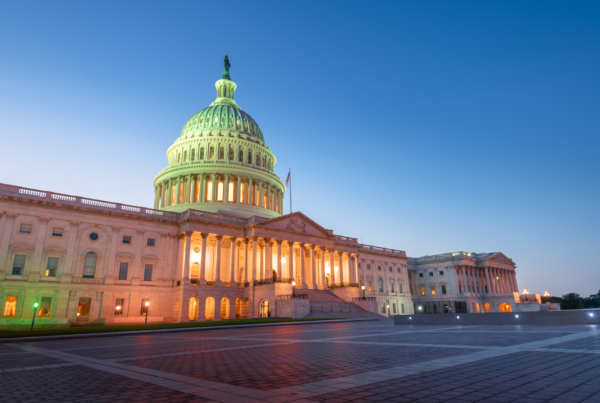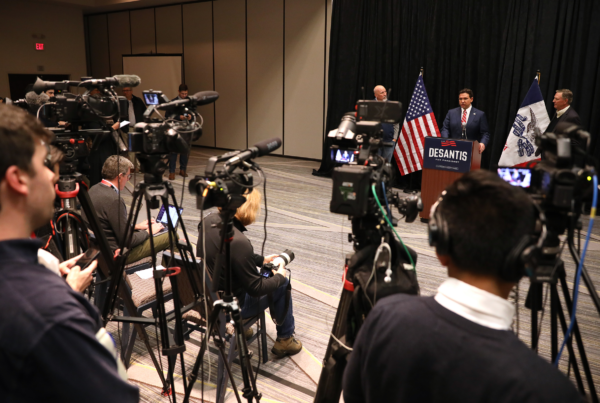Photo: GBlakeley/iStock
25 Percent of Pro-Republican House Ads in Past Week Mention Abortion
(MIDDLETOWN, CT) May 12, 2022 – Mentions of abortion in televised political advertising have risen in the wake of the leaked draft of the Supreme Court opinion that would overturn Roe v. Wade, according to a new analysis by the Wesleyan Media Project. The increase was especially pronounced in races for the U.S. House, where prior to May 3, 6.2 percent of pro-Democratic ads and 13.5 percent of pro-Republican ads mentioned the issue (Table 1). Since that day, 22 percent of pro-Democratic ads and 24.5 percent of pro-Republican ads have mentioned abortion. Increases in the frequency of abortion mentions are also evident in pro-Democratic Senate and gubernatorial ads and in pro-Republican gubernatorial ads.
“Clearly, the country’s attention has turned to abortion rights, and we’re seeing the shift in political advertising as well,” said Travis Ridout, co-director of the Wesleyan Media Project. “Abortion is an issue that not only separates Democrats and Republicans, but the issue could matter in primary races as well.”
Table 1: Mentions of Abortion Before and After Court Leak by Party and Race
| Pro-Democratic | Pro-Republican | |||
|---|---|---|---|---|
| Airings | % Mention Abortion | Airings | % Mention Abortion |
|
| HOUSE | ||||
| Before May 3 | 90,241 | 6.2% | 56,935 | 13.5% |
| After May 2 | 10,288 | 22.0% | 7,549 | 24.5% |
| 100,529 | 64,484 | |||
| SENATE | ||||
| Before May 3 | 92,706 | 0.6% | 233,168 | 12.2% |
| After May 2 | 6,071 | 6.1% | 14,052 | 11.8% |
| 98,777 | 247,220 | |||
| GOVERNOR | ||||
| Before May 3 | 182,931 | 10.3% | 314,560 | 4.4% |
| After May 2 | 7,643 | 12.8% | 32,237 | 10.0% |
| 190,574 | 346,797 | |||
| Figures are from January 6, 2021, to May 8, 2022. Numbers include broadcast television for all sponsors. CITE SOURCE OF DATA AS: Kantar/CMAG with analysis by the Wesleyan Media Project. |
||||
Races for Governor Heat Up
Table 2 shows the top races for governor in the current election cycle sorted by the number of ad airings. Atop the list are two races held last year, Virginia’s regular race for governor and California’s unsuccessful recall election. The race for governor of Illinois has featured more than 50,000 ad airings, many of them on the Republican side, where a number of candidates are vying for the top job. Republican Richard Irvin has aired over 25,000 ads to-date, and he has led in recent but limited polling. Republicans are vying to take on incumbent Democrat JB Pritzker, who has aired nearly 18,000 spots on broadcast stations through May 8. He first started advertising back in July 2021.
Similarly, there was significant activity in the Republican race in Nebraska, which held its primaries on May 10. The race for Governor, which is an open seat because incumbent Pete Ricketts is term-limited, featured over 42,000 ad airings through May 8. Former President Donald Trump backed Charles Herbster, an agribusiness executive, and Herbster sponsored over 18,000 spots in race, first placing ads on television in late June 2021. Herbster lost the primary to Jim Pillen, though, who first aired ads in April 2021 and sponsored nearly 13,000 as of May 8, 2022.
Georgia’s race for governor, with primaries on May 24, has also seen substantial spending, especially from interest groups; half the ads aired in the race have been sponsored by groups. On the Democratic side, Stacey Abrams has the field to herself, and she has aired over 8,000 spots since March 2022. Fair Fight Action, the group Abrams started, aired nearly 9,000 ads between September 2021 and February 2022, largely attacking the Republican Governor, Brian Kemp.
On the Republican side, former Senator David Perdue is challenging Kemp, with Perdue receiving the endorsement of former President Trump, who is still upset about Kemp’s handling of the 2020 election results in the state. Kemp has out-aired Perdue 5,000 spots to 3,000, but seven groups are also active in the race, including the Republican Governor’s Association (backing Kemp) and Make America Great Again, Again (backing Perdue).
Table 2: Ad Counts and Spending in Governor Races
| State | Airings | Est. Cost (in $Ms) | % Outside group airings | Dem group airings | Rep group airings | Dem cand airings | Rep cand airings |
|---|---|---|---|---|---|---|---|
| VA* | 105,615 | 50.86 | 2.4% | 1,248 | 1,277 | 51,798 | 46,614 |
| CA* | 74,936 | 37.81 | 67.1% | 47,403 | 2,847 | 0 | 24,682 |
| IL | 54,652 | 32.40 | 1.5% | 0 | 843 | 17,831 | 32,164 |
| NE | 42,158 | 10.47 | 10.7% | 0 | 4,499 | 0 | 37,659 |
| AL | 39,237 | 8.65 | 0.0% | 0 | 0 | 52 | 39,185 |
| GA | 32,790 | 19.67 | 50.7% | 8,996 | 7,620 | 8,095 | 8,078 |
| PA | 32,628 | 13.23 | 10.0% | 1,525 | 1,727 | 2,107 | 19,626 |
| NY | 24,215 | 9.36 | 12.1% | 430 | 2,505 | 7,922 | 13,358 |
| OH | 19,712 | 7.59 | 0.0% | 0 | 1 | 7,487 | 12,224 |
| OR | 17,358 | 4.46 | 0.0% | 0 | 0 | 4,587 | 10,383 |
| TX | 17,037 | 5.34 | 0.2% | 26 | 0 | 0 | 17,011 |
| NJ* | 12,588 | 16.96 | 22.3% | 2,813 | 0 | 7,398 | 882 |
| NV | 11,155 | 5.37 | 49.2% | 937 | 4,555 | 0 | 5,663 |
| OK | 8,724 | 3.71 | 77.9% | 496 | 6,297 | 0 | 1,931 |
| AZ | 8,244 | 4.82 | 25.4% | 1,201 | 895 | 416 | 5,732 |
| WI | 7,881 | 5.27 | 64.0% | 1,389 | 3,653 | 336 | 2,334 |
| MI | 7,537 | 3.68 | 9.1% | 5 | 682 | 0 | 6,850 |
| ID | 5,418 | 0.61 | 0.0% | 0 | 0 | 0 | 5,418 |
| CT | 4,188 | 2.01 | 10.3% | 0 | 430 | 1,193 | 2,558 |
| NM | 4,052 | 1.15 | 26.7% | 506 | 577 | 0 | 2,866 |
| KS | 4,006 | 1.34 | 57.6% | 1,315 | 993 | 1,698 | 0 |
| AR | 2,628 | 0.71 | 0.0% | 0 | 0 | 135 | 2,493 |
| NH | 1,215 | 1.95 | 100.0% | 1,215 | 0 | 0 | 0 |
| Figures are from January 6, 2021, to May 8, 2022. Numbers include broadcast television for all gubernatorial races with more than 1,000 airings. *2021 election. CITE SOURCE OF DATA AS: Kantar/CMAG with analysis by the Wesleyan Media Project. |
|||||||
Ohio Airwaves Inundated with Senate Ads, PA Very Distant Second
Ohio, whose Senate primaries were decided on May 3, has already seen almost 100,000 ad airings in the race for Senate (Table 3). Most of the ads were on the Republican side, which featured a competitive primary with multiple candidates. About 30 percent of those ads were sponsored by outside groups. The winner of the Republican primary, JD Vance, aired only 2,800 ads in the primary election, and he was out-advertised significantly by Mike Gibbons (21,600 spots), Matt Dolan (17,000 spots), and Josh Mandel (9,000 spots). But eight outside groups were active in the race, including Protect Ohio Values PAC, who backed Vance with 10,000 spots.
Other states seeing substantial ad spending in the Senate race are Pennsylvania (with primaries on May 17) and Alabama (May 24), but also Arizona, with primaries on August 2, and Wisconsin (August 9). Outside groups are heavily involved in these races, as well. Groups have sponsored 3 in 4 ads in the Arizona Senate race, for example. And groups have aired over 40 percent of the spots in early Wisconsin spending.
Pennsylvania is an open seat race, with competitive primaries in both parties. Significantly more ads have aired on the Republican side, with Mehmet Oz—TV personality and doctor—sponsoring 17,000 spots to businessman Dave McCormick’s 13,400. Here too, there are active outside groups, including 12,000 spots from Honor Pennsylvania, which has attached Dr. Oz.
Table 3: Ad Counts and Spending in Senate Races
| State | Airings | Est. Cost (in $Ms) | % Outside group airings | Dem group airings | Rep group airings | Dem cand airings | Rep cand airings |
|---|---|---|---|---|---|---|---|
| OH | 92,282 | 51.06 | 29.2% | 552 | 26,390 | 5,024 | 57,980 |
| PA | 56,845 | 39.77 | 36.5% | 1,311 | 19,417 | 4,994 | 31,123 |
| AL | 37,307 | 12.70 | 69.8% | 0 | 26,023 | 0 | 11,284 |
| AZ | 36,774 | 13.14 | 73.3% | 16,451 | 10,521 | 3,759 | 4,208 |
| WI | 34,172 | 14.49 | 43.4% | 14,833 | 0 | 11,399 | 7,808 |
| NC | 23,431 | 13.35 | 57.2% | 0 | 13,407 | 4,729 | 5,295 |
| NV | 18,168 | 5.11 | 68.4% | 7,543 | 4,877 | 4,611 | 989 |
| GA | 15,392 | 7.27 | 14.8% | 1,496 | 778 | 11,581 | 1,471 |
| AR | 9,058 | 3.23 | 54.6% | 0 | 4,943 | 0 | 4,112 |
| NH | 6,813 | 5.01 | 78.0% | 2,757 | 2,554 | 1,385 | 0 |
| MO | 3,920 | 2.34 | 69.8% | 0 | 2,737 | 0 | 1,183 |
| OK | 3,760 | 1.60 | 26.5% | 0 | 995 | 0 | 2,765 |
| CA | 2,198 | 1.01 | 0.0% | 0 | 0 | 2,198 | 0 |
| IA | 1,752 | 0.35 | 18.7% | 328 | 0 | 1,424 | 0 |
| AK | 1,143 | 0.24 | 96.6% | 1,087 | 17 | 0 | 39 |
| Figures are from January 6, 2021, to May 8, 2022. Numbers include broadcast television for all senatorial races with more than 1,000 airings. CITE SOURCE OF DATA AS: Kantar/CMAG with analysis by the Wesleyan Media Project. |
|||||||
May Primaries and Run-Offs Drive House Race Airings in TX, OH, OR
Advertising has also been substantial in several U.S. House races, as Table 4 shows. The House race seeing the most ads was Texas’s 28th district, which features a Democratic primary between Rep. Henry Cuellar and Jessica Cisneros. The Democratic primary in Ohio’s 11th congressional district, currently represented by Shontel Brown, also featured substantial advertising, as did Oregon’s 6th congressional district, which features more than a dozen candidates. All of the early spending in Iowa’s 3rd district was done by outside groups that aired spots in 2021 that promoted or attacked Democrat Cindy Axne for her positions on legislation. Axne won her election in 2020 by 7,000 votes from over 500,000 cast.
Table 4: Ad Counts and Spending in House Races
| State | District | Airings | Est. Cost (in $Ms) | % Outside group airings | Dem group airings | Rep group airings | Dem cand airings | Rep cand airings |
|---|---|---|---|---|---|---|---|---|
| TX | 28 | 14,123 | 3.75 | 31.1% | 4,075 | 312 | 9,736 | 0 |
| OH | 11 | 10,345 | 4.09 | 27.7% | 2,862 | 0 | 7,483 | 0 |
| OR | 6 | 9,027 | 6.31 | 59.7% | 5,386 | 0 | 3,110 | 531 |
| TX | 15 | 7,044 | 1.67 | 60.9% | 2,280 | 2,013 | 1,496 | 1,255 |
| GA | 7 | 6,869 | 5.92 | 64.5% | 2,507 | 1,925 | 2,437 | 0 |
| LA | 2 | 6,638 | 1.85 | 49.6% | 3,293 | 0 | 3,345 | 0 |
| IA | 3 | 5,815 | 3.30 | 100.0% | 2,867 | 2,948 | 0 | 0 |
| OR | 4 | 5,724 | 0.62 | 38.9% | 1,141 | 1,083 | 3,500 | 0 |
| NC | 13 | 5,362 | 2.63 | 23.0% | 0 | 1,232 | 1,316 | 2,814 |
| OR | 5 | 5,329 | 2.47 | 17.3% | 534 | 387 | 3,756 | 652 |
| PA | 8 | 4,941 | 1.53 | 53.8% | 1,394 | 1,262 | 0 | 2,285 |
| NM | 1 | 4,896 | 0.80 | 0.0% | 0 | 0 | 4,072 | 700 |
| OH | 15 | 3,772 | 2.02 | 30.1% | 0 | 1,135 | 891 | 1,379 |
| IN | 9 | 3,678 | 1.82 | 60.5% | 0 | 2,227 | 0 | 1,451 |
| FL | 20 | 3,564 | 0.96 | 0.0% | 0 | 0 | 3,564 | 0 |
| MI | 8 | 3,250 | 2.06 | 98.0% | 2,053 | 1,131 | 0 | 66 |
| ID | 2 | 3,184 | 1.44 | 73.6% | 0 | 2,343 | 0 | 841 |
| NC | 1 | 3,093 | 1.55 | 39.6% | 1,225 | 0 | 379 | 1,489 |
| KS | 3 | 3,087 | 1.49 | 100.0% | 1,785 | 1,302 | 0 | 0 |
| VA | 2 | 2,955 | 1.72 | 98.5% | 1,100 | 1,810 | 0 | 45 |
| ME | 2 | 2,922 | 1.32 | 100.0% | 262 | 2,660 | 0 | 0 |
| NV | 3 | 2,618 | 1.07 | 96.2% | 1,258 | 1,260 | 0 | 100 |
| OH | 9 | 2,293 | 0.93 | 48.9% | 0 | 1,122 | 0 | 1,171 |
| NE | 1 | 2,211 | 0.66 | 19.6% | 0 | 434 | 0 | 1,777 |
| KY | 3 | 2,177 | 0.91 | 25.0% | 544 | 0 | 1,526 | 107 |
| NC | 4 | 2,139 | 1.33 | 88.0% | 1,882 | 0 | 257 | 0 |
| NH | 1 | 2,032 | 2.22 | 99.7% | 910 | 1,115 | 0 | 0 |
| FL | 7 | 2,025 | 1.45 | 100.0% | 430 | 1,595 | 0 | 0 |
| VA | 7 | 2,022 | 0.71 | 100.0% | 646 | 1,376 | 0 | 0 |
| PA | 12 | 1,993 | 1.80 | 56.2% | 1,121 | 0 | 872 | 0 |
| AL | 5 | 1,916 | 0.52 | 9.1% | 0 | 175 | 0 | 1,741 |
| AZ | 1 | 1,392 | 0.69 | 81.6% | 1,136 | 0 | 0 | 256 |
| TX | 30 | 1,368 | 1.67 | 100.0% | 1,368 | 0 | 0 | 0 |
| FL | 13 | 1,273 | 1.46 | 100.0% | 1,273 | 0 | 0 | 0 |
| NC | 11 | 1,174 | 0.97 | 22.6% | 1 | 264 | 97 | 812 |
| SC | 7 | 1,149 | 0.24 | 0.0% | 0 | 0 | 0 | 1,149 |
| NY | 19 | 1,147 | 0.41 | 100.0% | 746 | 401 | 0 | 0 |
| NY | 24 | 1,013 | 0.42 | 100.0% | 1,013 | 0 | 0 | 0 |
| Figures are from January 6, 2021 to May 8, 2022. Numbers include broadcast television for all senatorial races with more than 1,000 airings. CITE SOURCE OF DATA AS: Kantar/CMAG with analysis by the Wesleyan Media Project. |
||||||||
Cycle-To-Date Totals
Cycle-to-date, as Table 5 shows, the Wesleyan Media Project has tracked over 1 million ad airings in federal and gubernatorial races, an increase of 32 percent over the same period for the 2018 cycle, which saw roughly a quarter of a million fewer ads. In addition, estimated total spending is approaching $500M this year compared to $315M in 2018. The level of activity in House races is down, but both senatorial and especially gubernatorial races have seen more ads in the 2022 cycle. Pro-Republican spots this cycle (for primary campaigns and early general election campaigning) substantially out-number pro-Democrats ads (650,000 to 390,000), which may reflect a greater number of competitive Republican primaries.
Interest groups have not been shy about wading into these races early on, as about 1 in 3 ad airings were sponsored by groups. Groups’ involvement was especially high in House races where they sponsored the majority of ad spots.
“Outside groups are often very active in the early going of an election cycle,” said Michael Franz, co-director of the Wesleyan Media Project. “Some groups wade into races expected to be competitive with promotional or attack messages in the off year, usually about legislation or issues. As the general election gets closer, the ads will focus less on legislation specifically and more on the candidates and their broader issue priorities.”
Table 5: Cycle-To-Date Ad Totals and Spending by Race, Sponsor and Party
| Democrats | Republicans | |||
|---|---|---|---|---|
| HOUSE | Airings | Est. Cost (in $Ms) | Airings | Est. Cost (in $Ms) |
| Candidates | 50,779 | 11.14 | 28,020 | 11.41 |
| Party | 384 | 0.24 | 9 | 0.01 |
| Coordinated | 0 | 0 | 365 | 0.06 |
| Groups | 49,366 | 21.21 | 36,090 | 19.26 |
| Total | 100,529 | 32.59 | 64,484 | 30.75 |
| SENATE | ||||
| Candidates | 51,296 | 26.96 | 128,786 | 56.64 |
| Party | 134 | 0.01 | 4,495 | 1.92 |
| Coordinated | 0 | 0 | 5 | ~0 |
| Groups | 47,347 | 17.27 | 113,934 | 68.07 |
| Total | 98,777 | 44.24 | 247,220 | 126.63 |
| GOVERNOR | ||||
| Candidates | 112,090 | 86.43 | 298,079 | 104.77 |
| Party | 3,984 | 0.86 | 1,606 | 3.56 |
| Coordinated^ | 4,678 | 2.79 | 7,647 | 3.88 |
| Groups | 69,822 | 22.3 | 39,465 | 25.82 |
| Total | 190,574 | 112.38 | 346,797 | 138.03 |
| Grand Total | 389,880 | 189.21 | 658,501 | 295.41 |
| Figures are from January 6, 2021, to May 8, 2022, and include some 2021 general election data as well as primary activity. Numbers include broadcast television. ^Coordinated includes some candidate/group coordinated ads. CITE SOURCE OF DATA AS: Kantar/CMAG with analysis by the Wesleyan Media Project. |
||||
Trump, Biden Mentioned Frequently
Ads from Republican candidates in federal races are focused on the current and former presidents. Anti-Biden messages are found in 36 percent of Senate ads, and 40 percent feature a pro-Trump message. Forty-five percent of House Republican candidate ads feature an anti-Biden message, and 37 percent feature a pro-Trump message. Biden and Trump are less of a focus in gubernatorial spots although they still appear. Republican gubernatorial candidates are more likely to attack Biden (20 percent), but they still promote Trump in a little more than one out of every ten ads (11 percent). Meanwhile Democratic gubernatorial candidates feature anti-Trump messages in roughly 14 percent of their advertising.
“Midterm elections are often a referendum on the incumbent president, and therefore, it is common to see ads attacking the president’s record in midterm advertising, especially from the opposing party” said Erika Franklin Fowler, co-director of the Wesleyan Media Project. “It’s much more unusual to see ads promoting a former president, and yet we are seeing a lot of that, just another sign of how important views of Trump are to the Republican primaries.”
About This Report
Data reported here from Kantar/CMAG do not cover local cable buys, only broadcast television, national network and national cable buys. All cost estimates are precisely that: estimates.
The Wesleyan Media Project provides real-time tracking and analysis of all political television advertising in an effort to increase transparency in elections. Housed in Wesleyan’s Quantitative Analysis Center – part of the Allbritton Center for the Study of Public Life – the Wesleyan Media Project is the successor to the Wisconsin Advertising Project, which disbanded in 2009. It is directed by Erika Franklin Fowler, professor of government at Wesleyan University, Michael M. Franz, professor of government at Bowdoin College and Travis N. Ridout, professor of political science at Washington State University. WMP personnel include Laura Baum (Associate Director), Breeze Floyd (Research Coordinator), Pavel Oleinikov (Associate Director, QAC), Markus Neumann (Post-Doctoral Fellow), and Jielu Yao (Post-Doctoral Fellow).
Data are provided by Kantar Media/CMAG with analysis by the Wesleyan Media Project. The Wesleyan Media Project is partnering again this year with the Center for Responsive Politics, to provide added information on outside group disclosure.
The Wesleyan Media Project’s digital advertising tracking is supported by the contributions of students in Delta Lab, an interdisciplinary research collaborative focusing on computationally-driven and innovative analyses and visualizations of media messaging.
Periodic releases of data will be posted on the project’s website and dispersed via Twitter @wesmediaproject. To be added to our email update list, click here.
For more information contact: Steven Scarpa at media@wesleyan.edu or 860-685-3813.
About Wesleyan University
Wesleyan University, in Middletown, Conn., is known for the excellence of its academic and co-curricular programs. With more than 2,900 undergraduates and 200 graduate students, Wesleyan is dedicated to providing a liberal arts education characterized by boldness, rigor and practical idealism. For more, visit www.wesleyan.edu.




